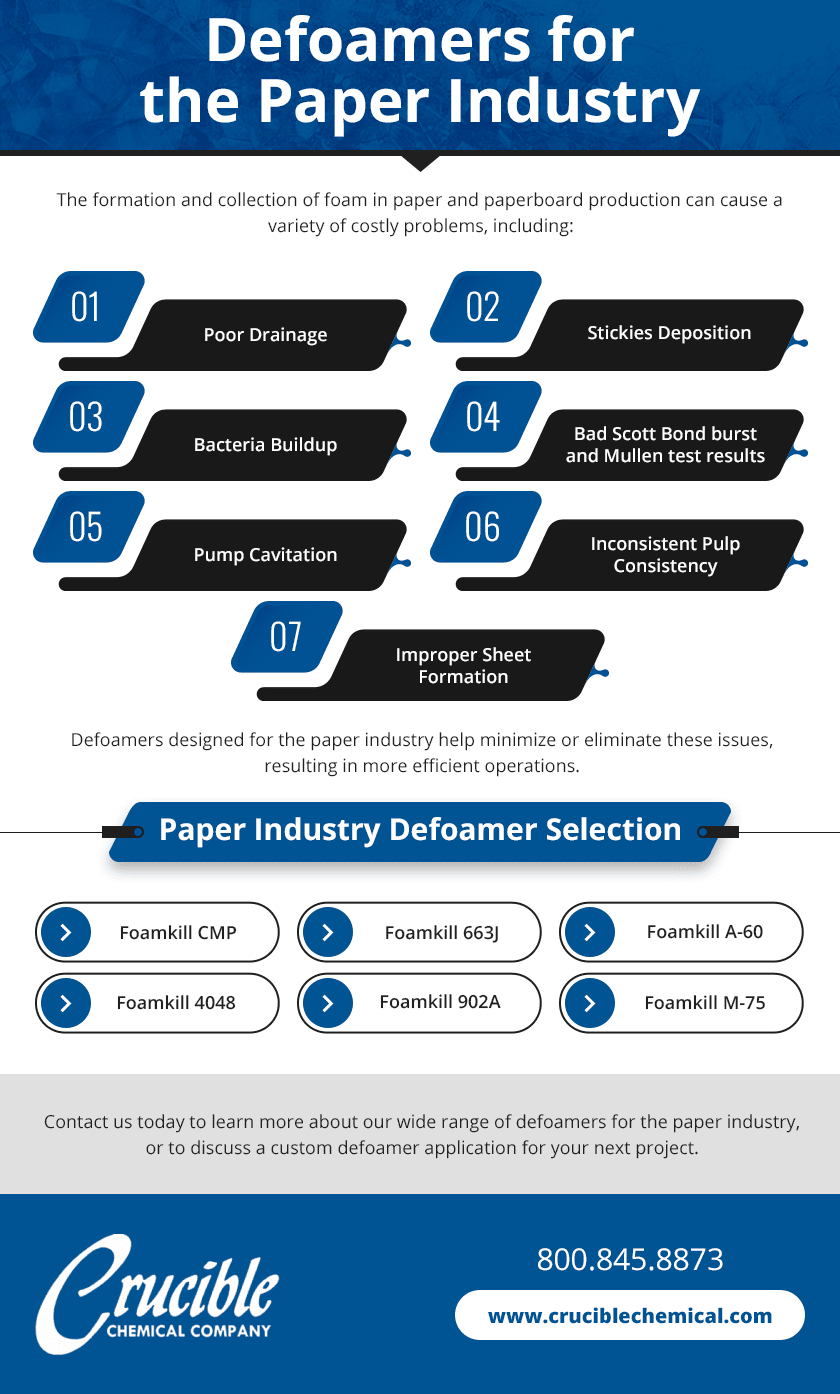The Duty of Defoamers in Enhancing Product Quality and Performance
In various making procedures, the existence of foam can dramatically impede item top quality and functional performance. Defoamers work as necessary additives that minimize this issue, ensuring smoother manufacturing operations while boosting the visual and practical characteristics of the end products (defoamers). Their application extends a wide range of markets, from food and beverage to drugs, where uniformity and integrity are extremely important. Nonetheless, the choice of the suitable defoamer can be essential to accomplishing optimum outcomes, increasing important inquiries about formula compatibility and efficiency metrics that merit more exploration.
Comprehending Defoamers
Recognizing the duty of defoamers is important for keeping product top quality across various sectors. Defoamers are chemical ingredients designed to minimize and protect against the formation of foam in fluid systems, which can negatively influence procedures such as mixing, filling up, and surface area stress. Lathering can cause inefficiencies, item problems, and jeopardized aesthetic appeal, making defoamers a vital component in producing procedures.
In industrial applications, defoamers assist to improve product consistency and security. For example, in the paint and finishes industry, foam can hinder the application process and the final surface. In a similar way, in food and beverage production, too much foam can hinder bottling and product packaging performance (defoamers). The efficient use of defoamers not only makes sure smoother production procedures yet additionally contributes to superior item performance.
Furthermore, the selection and formula of a defoamer must straighten with particular application requirements, such as compatibility with other components, effectiveness under varying temperature and pH problems, and prospective governing restrictions. Ultimately, recognizing defoamers' functions and their value in numerous formulas is essential for enhancing manufacturing and ensuring the finest quality output.
Types of Defoamers
Defoamers can be categorized into numerous kinds based on their composition and mechanism of activity. The key kinds include silicone-based, non-silicone organic, and not natural defoamers.
Silicone-based defoamers are among one of the most effective, largely as a result of their ability to spread promptly on the fluid surface area and disrupt foam development. Their special chemical framework allows for superior security, making them ideal for high-temperature applications and environments with varying pH degrees.
Non-silicone natural defoamers, usually made up of fatty acids or all-natural oils, are valued for their biodegradability and lower toxicity. These are normally made use of in food and beverage applications where security and environmental impact are paramount.
Not natural defoamers, that include substances like talc or calcium carbonate, act by boosting the density of the fluid, therefore lowering foam stability. They are often made use of in commercial processes where compatibility with various other materials is not a problem.
Each kind of defoamer has distinctive advantages and restrictions, enabling customized options relying on the specific foaming issues experienced in various applications. Understanding these differences is critical for optimizing performance and accomplishing desired item quality.
Applications Throughout Industries
Numerous industries utilize defoamers to enhance product quality and functional performance. In the food and beverage market, defoamers are critical in processes such as developing and dairy production Continued to stop foam formation, which can cause inadequacies and item incongruity. By regulating foam, producers can make sure better return and a more uniform product.
In the pharmaceutical market, defoamers play a crucial duty in the formulation of liquid medicines, where excessive foam can impede blending and exact application. Their use helps maintain the stability of the solutions and assists in smoother production processes.
The paint and coatings industry likewise relies upon defoamers to boost the performance of items throughout application. By decreasing foam, these ingredients make certain a smoother surface and boost the visual qualities of the end product.

Advantages of Making Use Of Defoamers
While the application of defoamers differs across industries, their advantages regularly improve product high quality and procedure performance. One considerable benefit is the decrease of foam development throughout making processes, which can or else lead to manufacturing delays and inconsistencies in item top quality. By decreasing foam, defoamers allow a smoother flow of materials, promoting more effective operations and lowering the chance of tools breakdowns.
In addition, using defoamers can boost the look and structure of end products. In industries such as coatings, paints, and food processing, too much foam can compromise the visual aesthetics and general top quality, while the suitable defoamer application makes sure a consistent finish and preferable attributes. Defoamers can contribute to cost financial savings by lowering waste during production and maximizing the use of raw materials.

Choosing the Right Defoamer
Selecting the appropriate defoamer is crucial for enhancing production processes and making certain product top quality. The choice of defoamer influences not only the efficiency of foam control yet likewise the general efficiency characteristics of the end product. Elements to take into consideration consist of the sort of application, the chemistry of the formulation, and the environmental conditions under which the product will certainly be made use of.
Various industries might need specific defoamer kinds, such as silicone-based, organic, or polymeric defoamers. Comprehending the compatibility of the defoamer with the primary components is important to prevent unfavorable responses that can endanger item stability. Additionally, the defoamer's efficiency in different temperatures and pH degrees need to be assessed to guarantee consistent performance.
Testing the defoamer in small-scale applications can give beneficial understandings right into its performance and suitability. Factor to consider of governing conformity, especially in food, pharmaceuticals, and cosmetics, is vital in choosing a defoamer. Eventually, a comprehensive evaluation of these elements will certainly bring about the option of a defoamer that not just manages foam properly however likewise boosts the high quality and performance of the final product.
Final Thought

Finally, defoamers are find more crucial ingredients that substantially improve item top quality and efficiency throughout different industries. By properly lowering foam formation, these representatives not only enhance operational performance however likewise contribute to the aesthetic and functional honesty of items. The critical selection and application of defoamers bring about cost savings, optimized source use, and increased client contentment. In general, the relevance of defoamers in industrial procedures can not be overstated, as they play a crucial duty in achieving consistent and premium end results.
Foaming can lead to inadequacies, item problems, and compromised visual charm, making defoamers a vital component in manufacturing operations.
